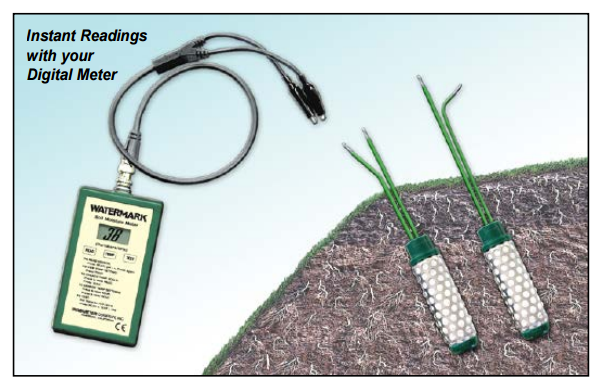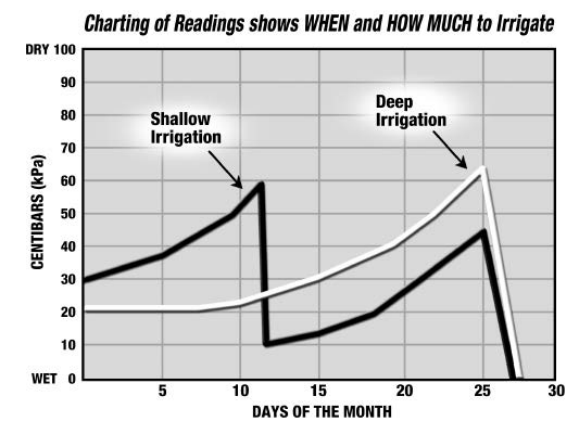Irrometer, 30-KTCD-NL, Watermark Digital Meterfor reading WATERMARK sensors in the field
30-KTCD-NL Includes Only:
- WATERMARK Digital Meter
- Cable assembly and instructions in a zippered case.
The WATERMARK Meter is a hand held device designed for reading WATERMARK sensors in the field. The digital readout displays the sensors' soil moisture status in centibars (cb) or kilopascals (kPa) of soil water tension. This value represents the energy a plant's root system uses to draw water from the soil. Whereas higher tension values indicate dryer soil, lower tension values indicate wetter soil. The meter's replaceable cable assembly has spring loaded clips for attaching to sensor leads. Users only need one meter to read any number of WATERMARK sensors. The meter comes in its own nylon case, padded and zippered for safe keeping when not in use.
Features:
- Large LCD display is easy to see in sunlight
- Touch pad operating panel is simple to use and has a self test function
- Quick release cable assembly is field changeable
- Adjustable for soil temperature variations
Operating Principle: The WATERMARK meter is designed to read all WATERMARK soil moisture sensors exclusively. These sensors have an output of 500 - 30,000 ohms of electrical resistance which is non-linear. The meter uses a solid-state alternating current resistance bridge meter for reading the sensors and converts the resistance value into centibars (cb) or kilopascals (kPa) of soil water tension. The reading is displayed on an LCD screen [range 0 -199 cb (kPa)]. Soil temperature values can be input by the user to compensate for their effect on sensor reading.
Specification Information: The soil moisture monitoring system shall incorporate Granular Matrix Sensors (GMS) to measure soil water tension. The sensors shall use a digital meter to read sensor values. The meter shall have a soil temperature compensation feature and self test functions on its tactile keypad. The meter shall be the model #30- KTCD-NL WATERMARK digital meter as manufactured by the IRROMETER Company, Inc. of Riverside, California.
| This illustration shows how the WATERMARK meter can be used to improve irrigation scheduling efficiency. Starting in the lower left quadrant of the chart, it appears that for the first nine days of the month the sensor readings indicate normal drying of the soil. At the ten day mark the soil water tension for the shallow sensor (black line) starts to spike to approximately 60 cb (kPa) which prompts the user to initiate an irrigation cycle. This has an immediate impact on the shallow sensor as indicated by the drop to 10 cb (kPa) which may be close to field capacity (depending on soil type). Notice that the deep sensor (white line) saw little impact from the irrigation event because it was short in duration. This was planned by the irrigator to apply water to the shallow roots only and not reach the deeper portion of the root zone. On the twenty-fifth day both sensor readings peaked prompting the irrigator to run a longer duration irrigation cycle which was significantly more effective based on the steep drop of the sensor reading at both depths. The WATERMARK sensors and meter provide a very effective method of monitoring soil moisture trends and can help growers make informed scheduling decisions. |  |
 |